Author: Matías Andrade Cabieses & Tanay Ved Source: Coin Metrics Translation: Shan Ouba, Jinse Finance
Key Points:
Prediction markets provide real-time, market-driven insights into event probabilities, offering a more dynamic alternative to traditional polling methods.
Polymarket has emerged as one of the most widely adopted prediction market platforms, built on the Polygon Layer-2 blockchain. It has accumulated over $200 million in TVL and consumes over 25% of the gas on Polygon.
Polymarket's 2024 US Presidential Election market has garnered significant attention, with Bitcoin's returns exhibiting a moderate positive correlation with election odds, suggesting intermittent linkages between cryptocurrencies and political sentiment.
Introduction
Traditionally, opinion polls have guided decision-making in areas such as political forecasting and consumer behavior. However, traditional polling methods and mainstream media are facing increasing scrutiny due to concerns over bias and lack of transparency. In this context, prediction markets like Polymarket have emerged as a compelling alternative, leveraging digital infrastructure and public blockchains (in Polymarket's case) to deliver real-time, market-driven forecasts that capture collective wisdom - qualities that have sparked immense interest in prediction markets, especially in the lead-up to the 2024 US Presidential Election. Polymarket now finds itself at a unique intersection, where political outcomes and market sentiment intertwine with the dynamics of digital assets.
In this article, we delve into how Polymarket's prediction markets operate on Polygon and analyze the data behind the 2024 Presidential Election market to understand its potential implications for digital assets.
What are Prediction Markets?
Prediction markets are platforms where users can buy and sell "contracts" representing the outcomes of future events. Similar to stock exchanges, where participants trade shares of listed companies, prediction markets allow users to trade based on the probabilities of specific events occurring. These events can range from the winner of the English Premier League to the next interest rate decision by the Federal Reserve. Prices typically represent the "yes" or "no" probability of an event, and they fluctuate as new information and changing sentiment emerge. Unlike traditional opinion polls, which provide valuable but instantaneous snapshots of public sentiment, prediction markets' unique strength lies in their ability to dynamically reflect information across a wide range of domains.
The concept of prediction markets can be traced back to several years ago, when various modern platforms emerged, from Kalshi and PredictIt to Augur and Polymarket. While they share the common goal of leveraging collective wisdom to forecast outcomes, they differ in their underlying technology, degree of decentralization, accessibility, and regulatory status. However, recently, Polymarket has emerged as one of the most widely adopted prediction market platforms, leveraging blockchain rails to achieve global accessibility, transparency, and low-cost settlement.
How Does Polymarket Work?
Architectural Overview
At the core of Polymarket is a blockchain-based prediction market, utilizing the Polygon Layer-2 network. It enables users to purchase "shares" representing different outcomes of future events. The platform operates as a hybrid on-chain application, with some components residing off-chain to support larger-scale transactions, while settling in a non-custodial manner on-chain.
Polymarket uses a central limit order book (CLOB) to facilitate trading between ERC-20 collateralized assets (currently only USDC) and Gnosis Conditional ERC-1155 assets (a multi-token standard). Essentially, users' USDC collateral units are split into binary outcome tokens ("yes" or "no"), maintaining a market price equal to one collateral unit. Users can acquire these tokens through direct trading on the order book or by interacting with AMM liquidity pools. "Operators" are the participants responsible for matching, ordering, and submitting transactions to the blockchain for settlement.
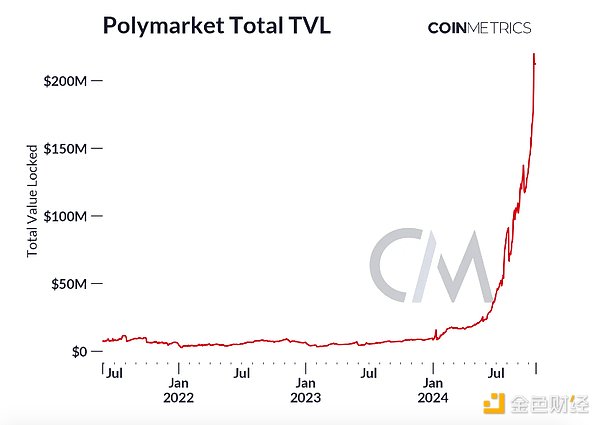
Polymarket also integrates with the UMA protocol's oracle to determine the correct outcome of events. If there is a dispute over the result, UMA token holders will vote to decide the final resolution. This hybrid approach, combining the Polygon network, Gnosis Conditional ERC-1155 tokens, a CLOB with off-chain order matching, and the UMA protocol's oracle, allows Polymarket to operate with higher scalability and performance compared to pure on-chain solutions. Due to its recent momentum, Polymarket has accumulated over $200 million in total locked value and contributes over 25% of the gas consumption on Polygon.
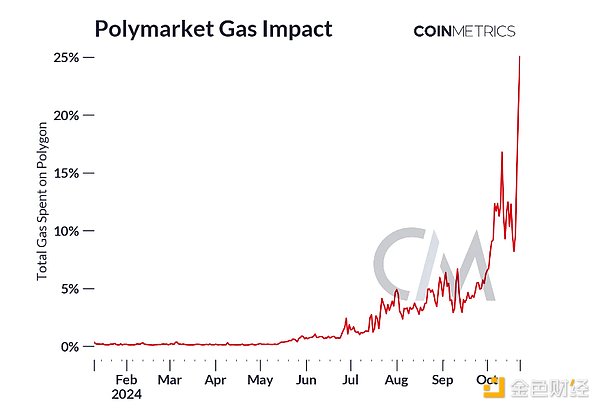
Understanding Events, Markets, and Odds
The core of Polymarket consists of events, markets, and odds, which work together to power the system.
Events are the specific outcomes that users are trying to predict, also known as the question. These outcomes can be political events (e.g., election results) or real-world events (e.g., weather or sports results). Markets are the platforms where users can bet on the potential outcomes of these events.
Polymarket offers two types of markets:
Single Multi-Outcome Markets: These markets allow users to bet on multiple possible outcomes of a single event. For example, "Which movie will have the highest box office gross in 2024?" The outcomes could include multiple movie titles, such as "Inside Out 2" or "Deadpool 3", with the probabilities of all outcomes summing to 100%.
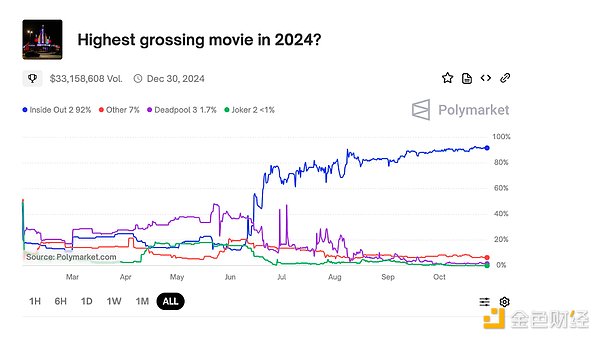
2. Mutually Exclusive Binary Markets: These markets have a simple "yes" or "no" proposition, where users can only bet on one of two possible outcomes. For example, "Will Bitcoin price be above $68,000 on November 1st?"
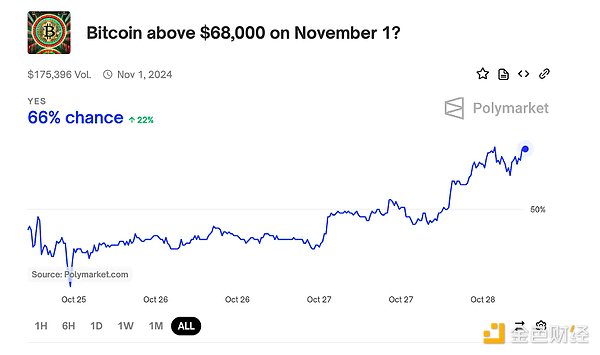
Users deposit USDC as collateral on the Polygon network to participate in these markets, which are then split into binary outcome tokens representing the "yes" or "no" positions. Users can trade these tokens through a centralized limit order book or on-chain AMM contracts, with the token prices (or "odds") reflecting the collective market assessment of the probability of each outcome. As market conditions change, the token prices fluctuate, allowing users to adjust their positions accordingly.
Once an event is resolved, anyone can use UMA to propose a resolution by posting a USDC bond, which they will receive as a reward if the outcome is undisputed. During the challenge period, when the event outcome is disputed, UMA token holders will vote to determine the final resolution. Poorly worded markets may lead to such disputes, as seen in a recent case regarding whether the Israeli military would invade Lebanon. After the event is resolved, the owners of the winning outcome shares can exchange them 1:1 for the USDC collateral, while the losing shares become worthless.
Outlook on the 2024 Presidential Election Market
The political category, particularly the "2024 US Presidential Election Winner" market, has been one of the most heavily traded and active markets on Polymarket. As of October 28th, the cumulative trading volume in this market has reached $2.5 billion since its inception. The stock prices (or odds) of each candidate have fluctuated significantly throughout the year, capturing changes in public perception and market sentiment as real-world events unfold.
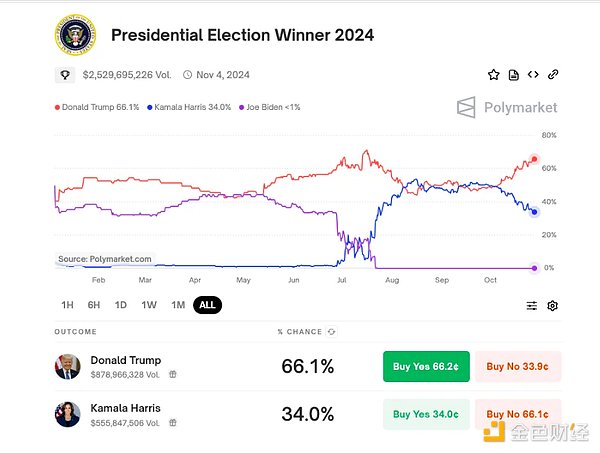
Trump's odds of winning hovered around 50% in early 2023, rising to over 65% in recent months, while Harris' odds increased after Biden's withdrawal from the race in July. Given Trump's pro-cryptocurrency stance, analyzing the relationship between candidate odds and Bitcoin prices can provide insights into the potential correlations between political and cryptocurrency market sentiment.

Due to the fact that the price of BTC has been basically fluctuating within a range over the past year, the relationship between it and Donald Trump's winning probability on Polymarket is currently unclear. However, they show a consistent period, especially during major trend reversals - for example, Trump's odds rose over 50% in May, fell below 70% in July, and recently climbed to 65% in October.
As shown below, the 30-day rolling correlation between BTC returns and odds changes provides a clearer picture. From May to August, Trump's odds were moderately positively correlated (peaking at 0.4) with BTC returns, while Harris' odds showed a relatively weak, often negative correlation, reflecting people's views on her stance on digital assets. Recently, both of these correlations have trended towards zero, indicating that while there is a short-term relationship, the long-term outlook for BTC is currently unrelated to the success of the two candidates. Instead, the market may be waiting for the election results before taking decisive action, with global factors such as money supply driving the broader trend of BTC.
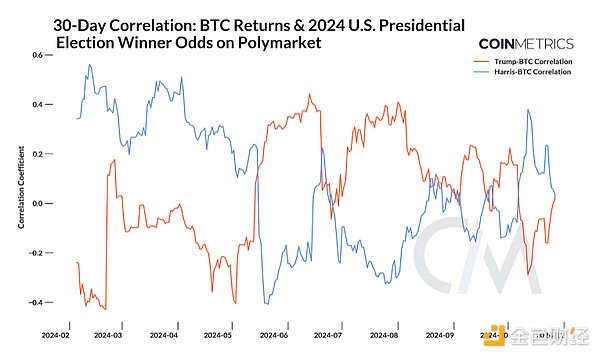
Looking Ahead
As a widely used blockchain-based prediction market, Polymarket has gained undeniable attention for its role in the pre-election period. However, it also faces certain challenges in terms of dispute resolution and regulatory review. Against the backdrop of rising Trump's winning odds, the platform has recently been accused of market manipulation by "whales". It appears that the reason for this divergence is that a user controls four accounts with a total of $46 million in election bets. Notably, other prediction markets and polls have also shown similar trends. While this does not indicate market manipulation, Polymarket as an offshore platform may continue to face regulatory hurdles, although the recent court ruling favorable to the US prediction market Kalshi may provide a precedent.
As the 2024 US presidential election enters its final stages, it remains to be seen whether Polymarket and similar platforms can maintain a leading role in decision-making. But they have clear and unique advantages, providing dynamic, transparent, and free-market-driven "sources of truth" that complement traditional models and proprietary data. The election results may further validate Polymarket's predictive capabilities and its value in informing sound decision-making.






